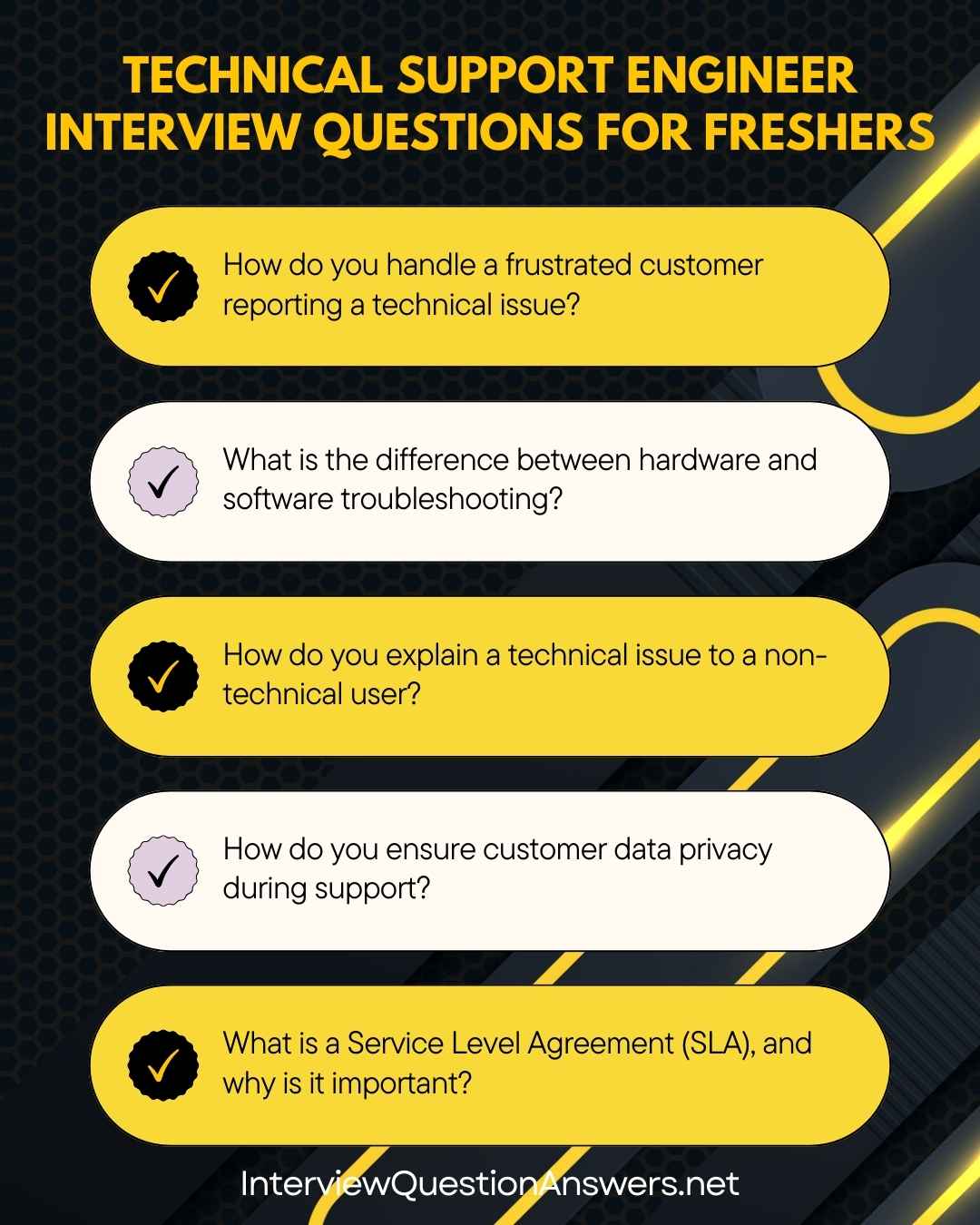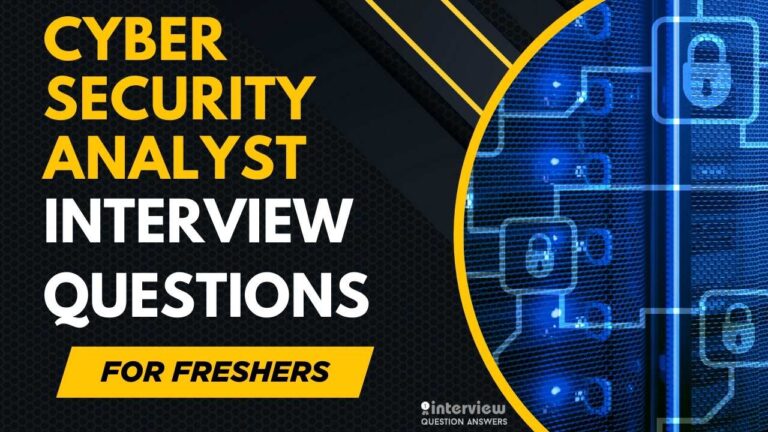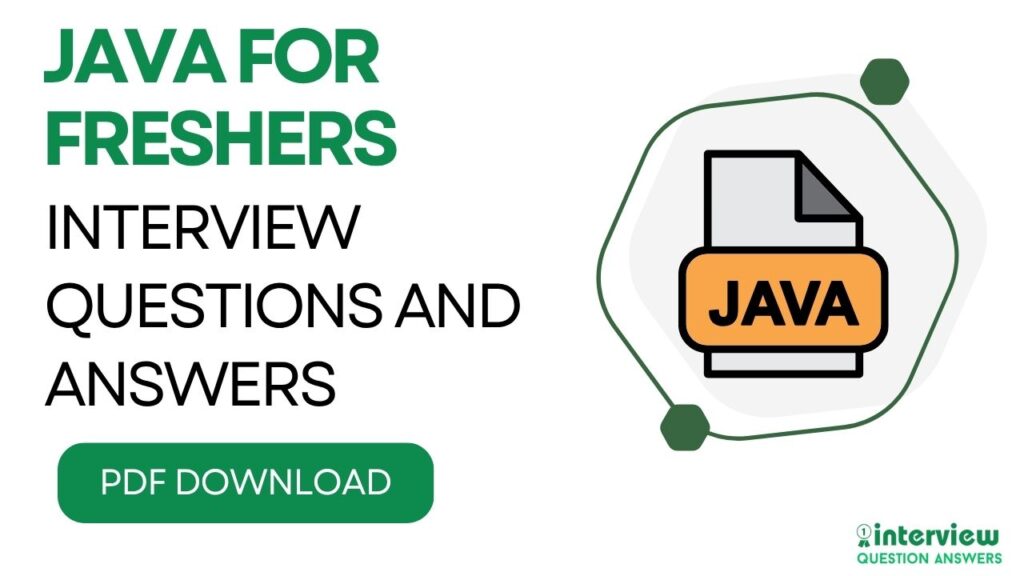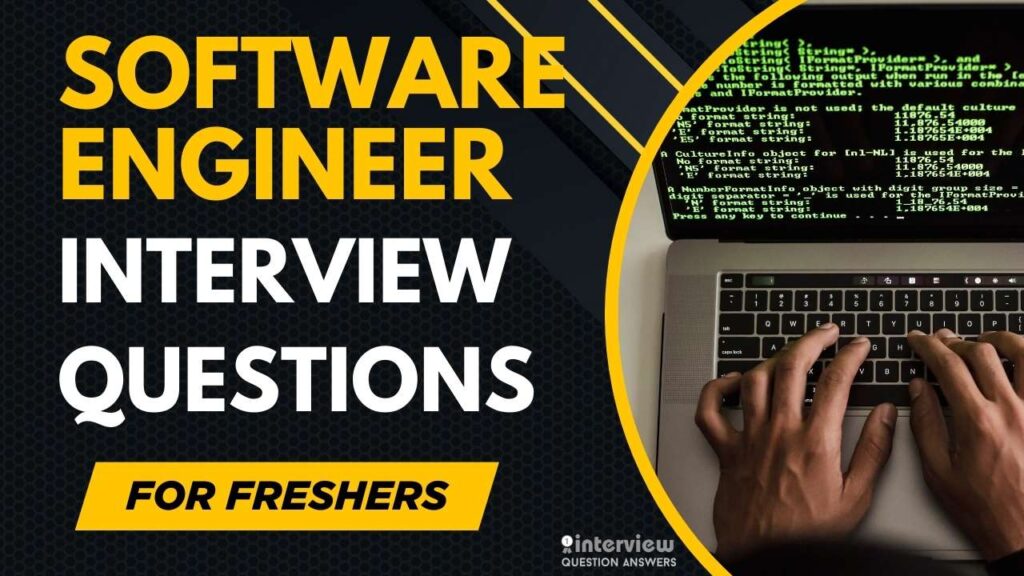Technical Support Engineer Interview Questions for Freshers
The technical support field continues growing with remote support tools, AI-assisted diagnostics, and omnichannel communication platforms becoming important skills for support engineers.
Technical Support Engineer Interview Questions cover troubleshooting methods, customer service skills, and technical knowledge that companies want from support professionals. Working as a technical support engineer means you need to solve complex technical problems while communicating clearly with customers who may not understand technical details.
This comprehensive interview guide includes Technical Support Engineer Interview Questions for Freshers seeking roles in technical customer support, covering system diagnostics, software troubleshooting, hardware issues, and effective communication techniques.
Table of Contents
Entry Level Technical Support Engineer Interview Questions
Que 1. What is the role of a Technical Support Engineer?
Answer:
A Technical Support Engineer assists customers or internal teams in resolving technical issues with hardware, software, or systems. They troubleshoot problems, provide solutions, and ensure customer satisfaction through effective communication and technical expertise.
Que 2. How do you handle a frustrated customer reporting a technical issue?
Answer:
Stay calm, listen actively, and empathize with the customer’s frustration. Ask clear questions to understand the issue, explain steps in simple terms, and follow up to ensure resolution. Document the interaction for future reference.
Que 3. What is the difference between hardware and software troubleshooting?
Answer:
Hardware troubleshooting involves diagnosing physical components like CPUs, RAM, or hard drives, often requiring physical inspection or diagnostic tools. Software troubleshooting focuses on applications or OS issues, using logs or configuration checks.
Que 4. How do you prioritize support tickets in a busy environment?
Answer:
Prioritize based on severity (e.g., critical system downtime), impact (e.g., number of users affected), and urgency (e.g., SLA deadlines). Use a ticketing system like Jira or Zendesk to track and manage tickets.
Que 5. What is a common tool used for remote desktop support, and how does it work?
Answer:
Tools like TeamViewer or Microsoft Remote Desktop allow remote access to a user’s system. They establish a secure connection over the internet, enabling screen sharing and control to diagnose and fix issues.
# Example: Start TeamViewer
teamviewer --startQue 6. How would you troubleshoot a computer that won’t boot?
Answer:
Check power connections, verify hardware (e.g., RAM, hard drive) is seated properly, and test with a different power source. Boot in safe mode, check BIOS settings, or use diagnostic tools to identify errors.
Que 7. What is an IP address, and why is it important in troubleshooting?
Answer:
An IP address is a unique identifier for devices on a network. It’s critical for troubleshooting network issues, like connectivity problems, by verifying correct IP configuration using commands like ipconfig or ping.
# Check IP address
ipconfigQue 8. How do you explain a technical issue to a non-technical user?
Answer:
Use simple language, avoid jargon, and relate the issue to everyday concepts. For example, explain a network issue as “like a blocked road preventing data traffic” and outline steps clearly.
Que 9. What is the purpose of a ticketing system in technical support?
Answer:
A ticketing system (e.g., ServiceNow, Freshdesk) tracks, organizes, and prioritizes customer issues. It ensures efficient issue resolution, maintains records, and supports team collaboration.
Que 10. How do you troubleshoot a slow computer?
Answer:
Check for high CPU/memory usage in Task Manager, scan for malware, clear temporary files, and update drivers. Optimize startup programs and consider upgrading hardware if needed.
# Clear temporary files (Windows)
del /q /f %temp%\*Que 11. What is the difference between TCP and UDP?
Answer:
TCP (Transmission Control Protocol) is connection-oriented, ensuring reliable data delivery, used for applications like web browsing. UDP (User Datagram Protocol) is connectionless, faster but less reliable, used for streaming or gaming.
Que 12. How do you troubleshoot network connectivity issues?
Answer:
Verify physical connections, check IP configuration with ipconfig, ping the gateway or external sites (e.g., google.com), and use tracert to identify network bottlenecks.
# Ping a server
ping 8.8.8.8Que 13. What is a DNS, and how does it relate to technical support?
Answer:
DNS (Domain Name System) translates domain names (e.g., google.com) to IP addresses. In support, DNS issues cause website access problems, resolved by flushing DNS or changing DNS servers.
# Flush DNS (Windows)
ipconfig /flushdnsQue 14. How do you ensure customer data privacy during support?
Answer:
Follow company policies, use secure tools (e.g., encrypted remote access), avoid storing sensitive data, and ensure compliance with regulations like GDPR or HIPAA.
Que 15. What is the role of log files in troubleshooting?
Answer:
Log files record system or application events, helping identify errors or crashes. For example, Windows Event Viewer or application logs can pinpoint the cause of an issue.
# Open Windows Event Viewer
eventvwrQue 16. How do you troubleshoot a software application crash?
Answer:
Check system requirements, update the software, and review logs for error codes. Reproduce the issue, clear cache, or reinstall the application if needed.
Que 17. What is a Service Level Agreement (SLA), and why is it important?
Answer:
An SLA defines response and resolution times for support issues. It ensures accountability, sets customer expectations, and drives efficient issue resolution.
Que 18. How do you troubleshoot a printer not printing?
Answer:
Check printer connections, ensure it’s online, and verify drivers are updated. Clear print queue, restart the spooler service, and test with a different device.
# Restart print spooler (Windows)
net stop spooler && net start spoolerQue 19. What is the difference between a router and a switch in networking?
Answer:
A router connects different networks (e.g., LAN to WAN), routing traffic based on IP addresses. A switch connects devices within a network, using MAC addresses to forward data.
Que 20. How do you document a technical support issue for future reference?
Answer:
Record the issue, steps taken, and resolution in a ticketing system. Include error codes, customer details, and timestamps to create a knowledge base for recurring issues.

Also Check: Technical Support Engineer Interview Questions for Experienced
Basic Technical Support Engineer Interview Questions for Freshers
Que 21. What steps do you take to troubleshoot a computer that is running slowly?
Answer:
Check Task Manager for high CPU or memory usage, scan for malware using antivirus software, clear temporary files, and update drivers. Disable unnecessary startup programs and consider hardware upgrades if needed.
# Clear temporary files (Windows)
del /q /f %temp%\*Que 22. How do you explain a network connectivity issue to a non-technical user?
Answer:
Use simple terms, like comparing a network issue to a “blocked road” for data. Explain steps clearly, such as restarting the router or checking Wi-Fi settings, and confirm understanding.
Que 23. What is the purpose of a firewall in a network?
Answer:
A firewall controls incoming and outgoing network traffic based on security rules, protecting systems from unauthorized access or threats. For example, Windows Firewall blocks suspicious connections.
Que 24. How do you troubleshoot a computer that fails to connect to Wi-Fi?
Answer:
Verify Wi-Fi is enabled, check signal strength, and restart the router. Ensure correct credentials, update network drivers, and use ipconfig to check IP configuration.
# Check network configuration (Windows)
ipconfig /allQue 25. What is a ticketing system, and how is it used in technical support?
Answer:
A ticketing system (e.g., Zendesk, ServiceNow) tracks and manages support requests, prioritizing issues and maintaining records. It ensures organized communication and timely resolution.
Que 26. How do you handle a situation where you don’t know the solution to a technical issue?
Answer:
Research the issue using documentation, knowledge bases, or forums. Escalate to senior support if needed, document findings, and follow up with the customer to ensure resolution.
Que 27. What is the role of Active Directory in technical support?
Answer:
Active Directory manages user accounts, permissions, and network resources in Windows environments. Support engineers use it to reset passwords or troubleshoot access issues.
Que 28. How do you troubleshoot an application that won’t open?
Answer:
Verify system requirements, check for updates, and review error messages or logs. Reinstall the application, clear cache, or run as administrator to resolve issues.
Que 29. What is DHCP, and why is it important in troubleshooting?
Answer:
DHCP (Dynamic Host Configuration Protocol) assigns IP addresses to devices on a network. Connectivity issues may arise from DHCP failures, resolved by releasing/renewing IP addresses.
# Release and renew IP (Windows)
ipconfig /release && ipconfig /renewQue 30. How do you ensure effective communication with a customer during support?
Answer:
Listen actively, use clear and simple language, confirm understanding, and provide regular updates. Summarize the issue and resolution to ensure customer satisfaction.
Que 31. What is the difference between a static and dynamic IP address?
Answer:
A static IP address is manually assigned and fixed, used for servers. A dynamic IP address is assigned by DHCP and changes periodically, common for client devices.
Que 32. How do you troubleshoot a blue screen error on a Windows computer?
Answer:
Note the error code, check Event Viewer for logs, update drivers, and scan for malware. Boot in Safe Mode or use System Restore to recover the system.
# Open Event Viewer (Windows)
eventvwrQue 33. What is a VPN, and how does it relate to technical support?
Answer:
A VPN (Virtual Private Network) creates a secure connection over the internet. Support engineers troubleshoot VPN connectivity issues, such as incorrect settings or firewall blocks.
Que 34. How do you troubleshoot a computer that freezes frequently?
Answer:
Check for overheating, monitor CPU/memory usage, update drivers, and scan for malware. Test hardware (e.g., RAM) and reduce system load by closing unnecessary applications.
Que 35. What is the purpose of a knowledge base in technical support?
Answer:
A knowledge base stores solutions to common issues, enabling faster resolution and self-service for customers. It improves efficiency and consistency in support.
Que 36. How do you troubleshoot an email delivery issue?
Answer:
Verify email settings (e.g., SMTP, IMAP), check spam filters, and ensure correct credentials. Test connectivity to the mail server using telnet or check DNS records.
# Test mail server connection
telnet smtp.example.com 587Que 37. What is the difference between a hub, switch, and router?
Answer:
A hub broadcasts data to all devices, a switch forwards data to specific devices using MAC addresses, and a router connects networks, routing traffic based on IP addresses.
Que 38. How do you troubleshoot a software update failure?
Answer:
Check internet connectivity, ensure sufficient disk space, and verify user permissions. Clear update cache, restart the system, or manually download the update.
# Clear Windows Update cache
net stop wuauserv && del /q /f "%windir%\SoftwareDistribution\*"
Que 39. What is the role of customer feedback in technical support?
Answer:
Customer feedback helps identify recurring issues, improve processes, and enhance service quality. It informs training needs and updates to the knowledge base.
Que 40. How do you document a support case for future reference?
Answer:
Record the issue, customer details, steps taken, and resolution in a ticketing system. Include error codes, timestamps, and solutions to build a searchable knowledge base.
Advanced Technical Support Engineer Interview Questions for Freshers
Que 41. How do you troubleshoot a network latency issue in a corporate environment?
Answer:
Use tools like ping or tracert to measure latency and identify bottlenecks. Check network configurations, verify QoS settings, and monitor bandwidth usage with tools like SolarWinds or Wireshark. Restart or reconfigure routers if needed.
# Trace network route (Windows)
tracert google.comQue 42. How do you handle a critical system outage reported by multiple users?
Answer:
Prioritize the issue, gather details from users, and check system logs (e.g., Event Viewer). Verify server status, network connectivity, and resource usage. Escalate to senior engineers if needed and communicate updates to users.
# Check Windows Event Logs
eventvwrQue 43. What is the role of Active Directory in troubleshooting user access issues?
Answer:
Active Directory manages user authentication and permissions. Troubleshoot access issues by checking user account status, group policies, and resetting passwords using tools like dsquery or PowerShell.
# Reset AD user password
Set-ADAccountPassword -Identity "username" -NewPassword (ConvertTo-SecureString "newpassword" -AsPlainText -Force)Que 44. How do you troubleshoot a VPN connection failure?
Answer:
Verify VPN credentials, check server settings, and ensure the client is updated. Test connectivity with ping, check firewall rules, and review logs for errors. Use diagnostic tools provided by VPN software (e.g., Cisco AnyConnect).
# Test VPN server connectivity
ping vpn.example.comQue 45. How do you use log analysis to resolve application errors?
Answer:
Analyze application logs (e.g., in /var/log or Windows Event Viewer) to identify error codes or stack traces. Correlate timestamps with user actions and use tools like Splunk or ELK Stack for advanced log analysis.
# View Linux application logs
tail -f /var/log/app.logQue 46. How do you troubleshoot a cloud-based application hosted on AWS?
Answer:
Check AWS CloudWatch logs and metrics for errors or resource issues. Verify EC2 instance status, security groups, and IAM roles. Test connectivity to services like RDS or S3 and restart resources if needed.
# Check CloudWatch logs
aws logs tail /aws/lambda/my-functionQue 47. What is the role of a packet sniffer in network troubleshooting?
Answer:
A packet sniffer (e.g., Wireshark) captures and analyzes network traffic to diagnose issues like packet loss or misconfigurations. Use it to inspect protocols, identify unauthorized traffic, or troubleshoot latency.
# Start Wireshark (Linux)
wireshark &Que 48. How do you troubleshoot a database connectivity issue?
Answer:
Verify database credentials, check network connectivity with telnet, and ensure firewall rules allow access. Review database logs (e.g., MySQL error logs) and confirm service is running.
# Test database connectivity
telnet db.example.com 3306Que 49. How do you handle a software licensing issue reported by a user?
Answer:
Verify the license key, check activation status, and ensure compliance with license terms. Contact the vendor if needed, update the license server, or reinstall the software to resolve activation errors.
Que 50. How do you troubleshoot a server that is unresponsive?
Answer:
Check server status via monitoring tools (e.g., Nagios), verify network connectivity, and review logs for errors. Restart services, check resource usage (CPU, memory), and escalate to system admins if hardware issues are suspected.
# Check server processes (Linux)
topQue 51. How do you use scripting to automate repetitive support tasks?
Answer:
Use PowerShell or Bash to automate tasks like user account creation or log analysis. For example, a script can reset passwords or clear temporary files across multiple systems.
# PowerShell script to clear temp files
Get-ChildItem -Path $env:TEMP -Recurse | Remove-Item -ForceQue 52. How do you troubleshoot a Group Policy issue in Active Directory?
Answer:
Use gpresult to verify applied policies, check Event Viewer for GPO errors, and ensure the client is connected to the domain. Test policy updates with gpupdate and validate permissions.
# Force Group Policy update (Windows)
gpupdate /forceQue 53. How do you ensure compliance with IT security policies during support?
Answer:
Follow company policies, use encrypted tools (e.g., SSH, RDP), avoid storing sensitive data, and log actions in a ticketing system. Ensure compliance with regulations like GDPR or HIPAA.
Que 54. How do you troubleshoot a cloud storage access issue (e.g., AWS S3)?
Answer:
Verify IAM permissions, check bucket policies, and ensure correct endpoint URLs. Test access with AWS CLI and review CloudTrail logs for unauthorized access attempts.
# Test S3 access
aws s3 ls s3://my-bucketQue 55. How do you handle a situation where a user reports intermittent application performance?
Answer:
Reproduce the issue, check application logs, and monitor resource usage (CPU, memory). Use tools like New Relic or CloudWatch to analyze performance trends and identify bottlenecks.
# Check CloudWatch metrics
aws cloudwatch get-metric-statistics --metric-name CPUUtilization --namespace AWS/EC2Que 56. How do you troubleshoot a remote desktop connection failure?
Answer:
Verify RDP settings, check firewall rules, and ensure the remote system is online. Test connectivity with ping, check credentials, and review Event Viewer for errors.
# Test RDP connectivity
ping remote.example.comQue 57. How do you use monitoring tools to proactively identify issues?
Answer:
Use tools like Zabbix or AWS CloudWatch to monitor system metrics (e.g., CPU, disk usage). Set alerts for thresholds and review dashboards to detect issues before users report them.
# Set CloudWatch alarm
aws cloudwatch put-metric-alarm --alarm-name HighCPU --metric-name CPUUtilization --threshold 80Que 58. How do you troubleshoot a web application not loading in a browser?
Answer:
Check browser console for errors, verify server status, and test network connectivity. Clear cache, check DNS resolution, and review server logs (e.g., Apache, Nginx) for issues.
# Check Nginx logs
tail -f /var/log/nginx/error.logQue 59. How do you escalate a complex technical issue to a higher support tier?
Answer:
Document the issue, steps taken, and logs in the ticketing system. Provide a clear summary to the next tier, including error codes and user impact, and follow up with the customer.
Que 60. How do you maintain a knowledge base for technical support?
Answer:
Document common issues, solutions, and error codes in a knowledge base (e.g., Confluence). Update it regularly with new resolutions and share with the team to improve efficiency.
Conclusion
We have covered all the essential questions in our Technical Support Engineer Interview Questions guide above. This complete resource includes interview questions for support professionals, covering both technical scenarios and customer service situations that employers commonly evaluate.
These Technical Support Engineer Interview Questions for Freshers will help you show your problem-solving abilities, demonstrate your patience with frustrated customers, and prove you can provide excellent technical assistance in fast-paced support environments.
Similar Guides:













